“Obscurity … has hung like a cloud of oblivion over the history of this island.” Franklin Hough, 1880
By 1875, local folks had forgotten the story of the old fort on Carleton Island, referring to the ruins as “the French Fort.” The place was still a mystery until the later in the nineteenth century, when historians Franklin Hough and J. H. Durham undertook research and publications about Fort Carleton, as it was still known.
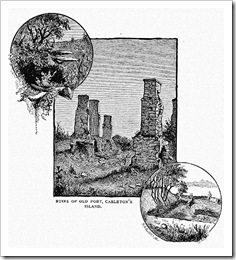
Benjamin Lossing in 1867 said, “At what precise time fortifications were first erected there is not positively known." He wrongly stated, "The English found it quite a strongly fortified post at the time of the conquest of Canada, at a little past the middle of the last century, and, perceiving its value in a military point of view (for it commands the main channel of the St. Lawrence), they greatly strengthened it."
Tthe historian Emerson observed, [1898] “In regard to its origin and date of construction there was much conjecture, and not a little controversy among students of history,” … “until within the last score of years it was supposed that the fort was built by the French between 1758 and 1760, or during the last French and English struggle for supremacy on this side of the Atlantic, while some writers have ascribed it to a still more ancient origin, dating back in some cases almost to Champlain's time.”
Research prior to 1880 by the eminent North Country historian, Dr. Franklin B. Hough, in the archives of the Dominion Government at Ottawa, subsequently revealed that this was never a French fort, but had been constructed by the English. Dr. Hough provided an extensive, detailed account of the sources that came to light.
Eight tons of historical papers, dating from 1760 to about 1873, plus 233 volumes known as the “Haldimand Papers,” supplemented by the “Simcoe Papers” in the Library of Parliament, together told the story.
Carleton Island was never occupied by the French, other than as occasional stopping place. Father Charlevoix who visited the island in 1720, left the first French reference, to "a pretty port that can receive large barques."
No historians on either side mentioned Carleton Island related to the events of the French and Indian War (1754-1760), which would be expected had any fort here been of consequence or had the river been expected to be a frontier of hostilities. The earliest mention during that period was July 1777, when “Buck Island” was beginning to be used for military purposes—mostly as a point of rendezvous and supply, although still without fortification.
Two years later, in spring of 1779, during the Revolutionary War, the Americans learned from two Native American prisoners that the British were fortifying themselves at Carleton Island. A garrison there consisted of Sir John Johnson’s Regiment, totaling less than two hundred men, but due to “disorder among them … they died very fast and that no other reason made him and some others leave that place.”
A surviving order book of the period, kept at Carleton Island, in an entry for May 14 refers to a “fort, alarm posts, the duties of engineers and artisans, and the usual routine of garrison life.”
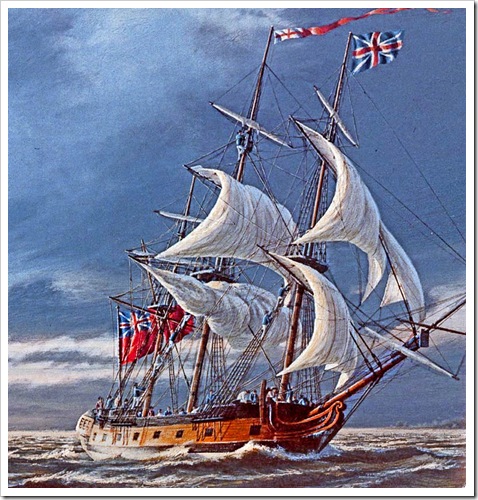
Limnaide. Painting by Peter Rindisbacher from Legend of the Lake by Arthur Britton Smith
The ship Limnaide appeared, with the scow Seneca and sloop Cladwell, Mohawk, etc., as expense items at Carleton Island.
The records are so complete, according to Dr. Hough, that “it would be easy indeed, to fish from the Sea of Oblivion scores of names, of high and low degree, down to the humblest laborer, and the chimney-sweep … and the chimneys still standing are silent witnesses of the accuracy of these accounts.”
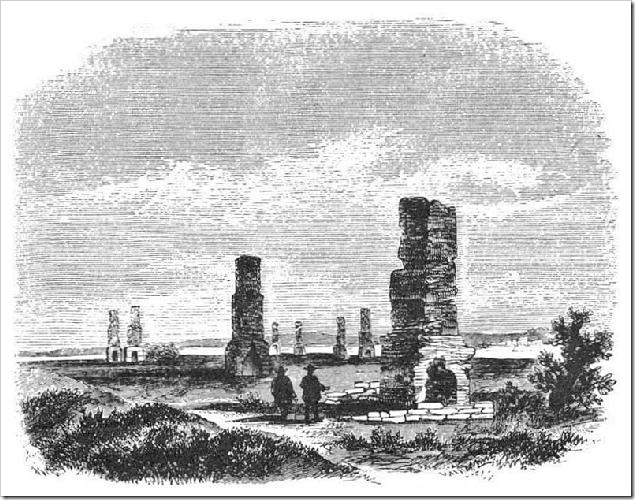
Fort Haldimand chimneys (Lossing, 1869). “Nine bare chimneys have stood there ever since, gray and solitary tokens of change. There were about twenty originally within the fort, some of which are in ruins” (Lossing. 1869).
Some writers, such as Edgar Emerson (1898), seemed to credit Maj. J. H. Durham with discovering the real history of Ft. Haldimand. Hamilton Child in 1890 said, In the history of Carleton Island and the Old Fort recently by Major J. H. Durham, of Cape Vincent, is a letter written October 14, 1778, by Gen. Sir Frederick Haldimand … which proves conclusively that the fort was built by the English in that year.”The mentioned work of Durham was apparently an unpublished earlier version of his 1889 small book, with a different title, Carleton Island in the Revolution.
Maj. Durham located the critical letter in question in St. Catherines, Ontario, in the collection of a historical society there:
General Sir Frederic Haldimand to Lord George Germain, His Majestiy’s Secretary of State.
Camp at Sorel, 14th Oct., 1778
My Lord: I sent Mr. Twiss of the of the Engineers with Capt. Aubrey and three Co.s remaining of the 47th Regt in Canada a detachment from Sir John Johnsons Corps, together with a body of Artificers to establish a post at the entrance to Lake Ontario to serve the purposes of a safe place for the traders to send their goods to, which go from Montreal in Boats, till the kings vessels now the only craft allowed to navigate the Lakes can be spared from the more urgent services, to transport them to Niagara, a secure harbor for these vessels, and a defence against the enterprises of the Rebels upon this province by that great avenue into it. I also sent up with the same party Lieut. Schank of the Navy, … Commissioner of the Dock Yards, for the benefit of his judgment with regard to the best places for a Harbor, and with orders to construct as soon as possible for that Lake a number of Gun Boats which are so useful in many respects. I sent him also the Inspection and arrangement of the Kings vessels there.
Later historians Emerson and Child may have supposed that Durham's publication of the Haldimand letter was new evidence revealing the true history of Carleton Island. It appears, however, that Dr. Hough already had published his key historical findings in 1880, in The Thousand Islands of River St. Lawrence. In his earlier (1853) A History of Jefferson County, Hough referred not to “Fort Haldimand” but rather to “Fort Carleton,” but at that earlier date provided mostly a description rather than a history.
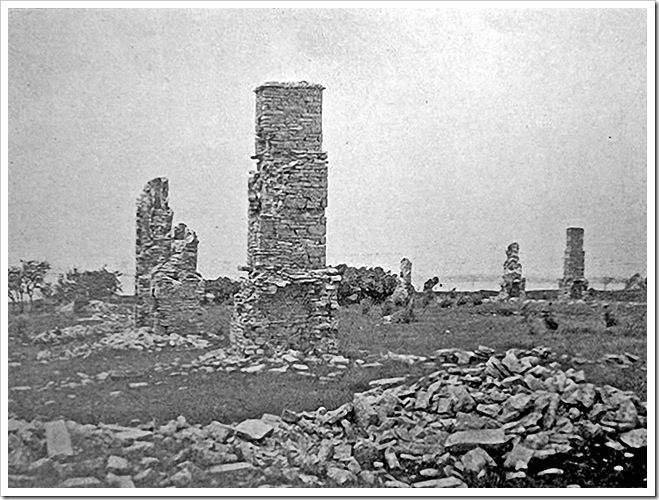
“Five of the massive stone chimneys are still standing,” (Childs, c. 1890). Photograph of five remaining chimneys (Haddock, 1895).
To move back in time from these historians, who reconstructed history in retrospect, we have some contemporary accounts and descriptions from the earlier times. The Haldimand letter, above, observed about the fort:
"The place pitched upon by these gentlemen, after having been carefully examined, is an island about 12 miles below the entrance of Lake Ontario, having Grand Isle (now Wolfe) on one side, from which it is divided by a channel of something less than a mile, and the south continent on the other, at a distance of one mile and a quarter from it. ... The name of Carleton Island is now given to this in question. Very favorable ground for fortifying, commanding a commodious and safe harbor which the island posses at the upper end of it looking toward the lake, induced the gentlemen sent on this service to fix upon this spot, where a fort is begun, and barracks are building for the troops, and the place will be in tolerable state of defense and habitation by the winter."
Officers Twiss, Shank, and Aubrey from the inception were central to construction and operation of Fort Haldimand. Capt. Aubrey--a name coincidentally still prominent in Cape Vincent--“remained in command of Carleton Island for a long time.” Maj. Durham tells us:
"Capt. Thomas Aubrey belonged to a very ancient English family. He was the second son of Sir Thomas Aubrey Bart, and entered the army as an ensign in Oct. 1762. In 1765 he was promoted to a lieutenancy, and in 1771 became a captain in the 47th and two years later came with his regiment to America where he served during the Revolutionary war. In 1778, he, with three companies of his regiment, and a detachment of Sir John Johnson's Reg't [The Royal Greens] were sent to Carleton Island to establish a post there in company of Lieut. Twiss and a body of Artificers. ... He became a major in 1785, and in 1788 he exchanged with Capt. John Irving and retired. He became a member of Parliament and died in London, Jan. 15, 1814."
Lieut. John Shank was a naval, rather an army officer. He was responsible for establishing the shipyard at Carleton Island and constructing vessels there. Initially they built small whale boats (20' to 25' two-masted and oar-assisted) to be used for military raiding parties against the Continental Army's rear guard in the Mohawk Valley.
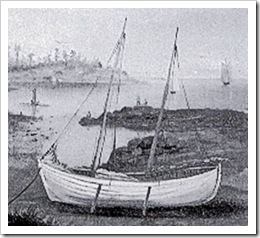
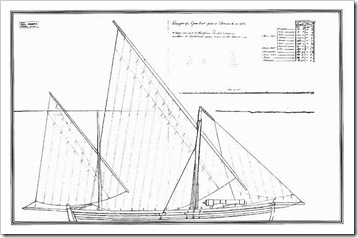
In 1780 the twenty-two gun brig sloop Ontario came off the ways. She was the largest war ship on the Great Lakes at the time.
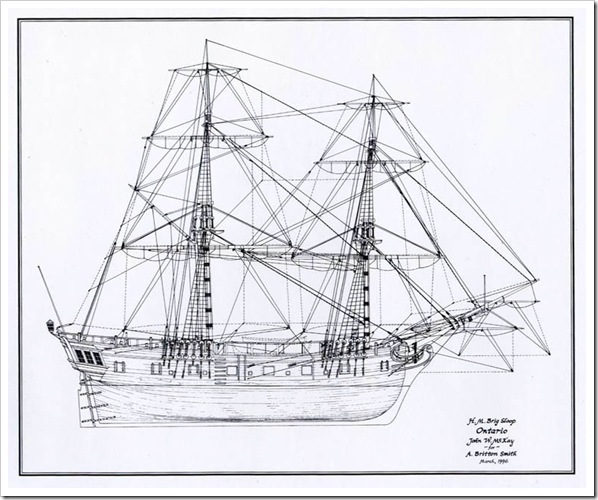
H. M. Brig Sloop Ontario. John W. McKay drawing.
"Ontario floundered on Halloween night of 1780 in a sudden and violent hurricane while en-route from Fort Niagara to Oswego. At least eighty-eight men, women and children perished, including her Captain, James Andrews. No wreckage was ever found1[1] and only 6 bodies eventually washed up on shore. News of this great military loss was kept secret for a number of years. To this day, the exact location of the wreck remains a mystery. Many marine archeologists believe Ontario may remain in pristine condition in her deep, cold fresh water grave in the depths of Lake Ontario." Doran Bay Ships
1
The ship Ontario was found in the summer of 2008. TI Life will have feature article about this discovery in a later issue, SWS November 2008.
Next the shipyard produced the Limnade (shown in a painting above) very similar in size, although rigged and masted differently than Ontario.The sixteen-gun Haldimand was also stationed at Carleton Island (shown at right in painting below, which conveys at shipyard activity here).
The ruins of Haldimand is at the bottom of the North Bay at Carleton Island today as well as those of the gunship Charity.
Maj. Durham tells us:
Lieut. John Schank was descended from a very ancient Scotish family whose records extend beyond the reigh of Robert Bruce. He was born in 1740, and went to sea at an early age in the merchant service, serving for the first time on a man of war in 1757, the Elizabeth of 74 guns commanded by Sir Hugh Pallisser. He came to American as a midshipman on the Barfleur, a 98 gun ship. He was inventor of the center board for vessels and built the first one of the kind for Lord Percy in "Boston in 1774. He was promoted to a lieutenancy in the Navy in 1776, and immediately thereafter, superintendent of the Naval Department at St. Johns. A great feat of Lieut. Shanks was the building of the Inflexible, a vessel of 300 tons having only the help of sixteen carpenters, completely fitting her out, manning, equipping, arming, and successfully fighting her against an enemy in six weeks from the laying down of her keel. In 1778 he was sent to Carleton Island by Gen. Haldimand to arrange for the building of vessels and gun boats for Lake Ontario, and at one time he had the direction of four dock yards located at Quebec, St. Johns, Carleton Island, and Detroit. He was no less celebrated for his skill in construction, than for his economical expenditure of the public money, at a time when perculation was the well neigh invariable characteristic of the British disbursing officer. In 1780 he was promoted to be a Master and commander in the Navy, and in 1783 he became a post-captain. He passed through the various grades of Admiral, and reached that of Admiral of the Blue, July 19, 1821. He was the inventor of many improvements to vessels....
Added to this troika of officers at Fort Haldimand was Rene-Hippolyte Laforce who had been responsible for construction of the Seneca (pictured below), then became her captain. Subsequently Laforce became supervisor the the Carleton Island shipyard and received commission as commodore of the fleet.
We should not envision these officers living in log barracks within the fort. Like Molly Brant, who had a "mansion" on Carleton Island, they would have had more commodious houses outside the fortifications, surrounded by gardens.
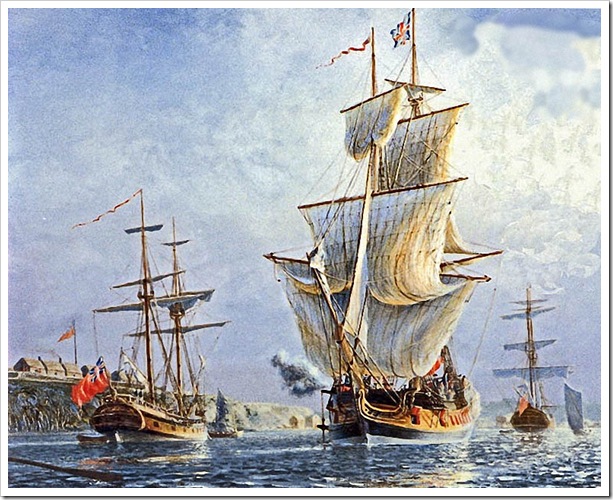
"Seneca, Ontario, and Haldimand at the Carleton Island Anchorage in May 1780." Painting by Peter Rindlisbacher from Legend of the Lake by Arthur Britton Smith.
Lieutenant William Twiss was an engineer, responsible for design, construction and maintenance of the Carleton Island facility. Maj. Durham tells us:
William Twiss was born in 1745 and entered the military department of the ordnance in 1760, and was commissioned as ensign and "Practical Engineer, in the Royal Engineers in 1764. He was promoted to Lieutenant and Sub Engineer in 1771, being at that time in service at Gibraltar. From 1772 to 1775 he was employed on the new Fortifications at Plymouth and early in 1776, he was sent out to Gen.Carleton. He landed in Quebec late in May, and on the 10th of June he was assigned to duty on the staff of major Gen. Phillips. In conjunction with Lieut. Schank of the Navy he constructed a fleet for Lake Champlain. In the spring of 1777, he was appointed Chief Engineer of Burgoyne's Army. He served throughout Burgoyne's campaign, and was included in the Saratoga Convention, but was shortly exchanged and returned to Ticonderoga, which post he assisted in evacuating in Nov., 1777.
In the autumn of 1778 he, together with Capt. Aubrey of the 47th, and Lieut. Schank of the Navy, was sent by Gen. Haldimand, Sir Guy Carleton's successor, to establish a post at the entrance to Lake Ontario. He was steadily promoted from time to time, and in later years was considered the best engineer in the English service. He died at the age of 82, having reached the grade of General.
A map dated 1810 shows the fort site at the time, mentioning a wreck in North (Shanks) Bay:
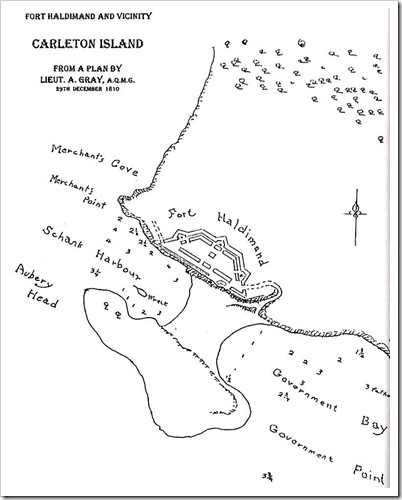
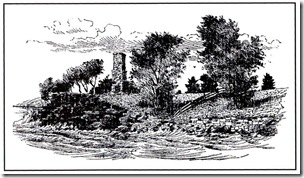
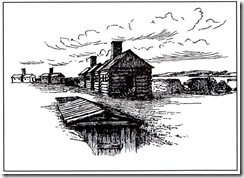
Conjectural reconstruction sketch of two log barracks sharing a single chimney. Pen drawings by Prof. N. A. Wells of Queens University from pencil sketches by Maj. Durham.
In 1813, after Fort Haldimand was occupied by the Americans, Benjamin Lossing, in his Pictorial Field Book of the War of 1812, observed:
“As we approached the rocky bluff at the head of the island we observed several chimneys standing alone (built of stone, some perfect, some half in ruins), which mark the remains of strong and somewhat extensive fortifications erected there by both the French [sic] and English during the last century, that post being a key to the internavigation of the St. Lawrence River and Lake Ontario.” Of course, Lossing was wrong in supposing the French had built fortifications here. He added:
“There were also chimneys on the little peninsula … and along the shore northward, where, on a fine grassy point, vestiges of the gardens that were attached to the officers’ quarters may yet be seen.”
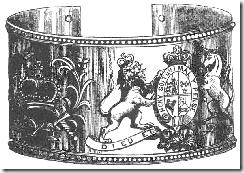
Silver armlet from Native American grave, Carleton Island. “The chief who bore the armlet and gorget was probably one of the expedition [from the Mohawk Valley to Montreal] who perished there [at Carleton island]. Lossing, 1865.
In 1813, after Fort Haldimand was occupied by the Americans, Benjamin Lossing, in his Pictorial Field Book of the War of 1812, observed:
“As we approached the rocky bluff at the head of the island we observed several chimneys standing alone (built of stone, some perfect, some half in ruins), which mark the remains of strong and somewhat extensive fortifications erected there by both the French [sic] and English during the last century, that post being a key to the internavigation of the St. Lawrence River and Lake Ontario.” Of course, Lossing was wrong in supposing the French had built fortifications here. He added:
“There were also chimneys on the little peninsula … and along the shore northward, where, on a fine grassy point, vestiges of the gardens that were attached to the officers’ quarters may yet be seen.”

Hospital chimney on point.
Lossing continued: “We moored our boat in a small sheltered creek by which the head of the island is made a pleasant peninsula of eight or ten acres. On this stand the residences of Mr. Charles Pluche, an intelligent French Canadian (who owns five hundred acres of the western end of the island), and of his brother. That creek separates the peninsula from the higher bluff on which the ruins of Fort Carleton are seen. Mr. Pluche kindly accompanied us to these ruins and other interesting places near, and, but for the increasing violence of the wind, which became almost a gale at noon, our visit would have been one of unmixed satisfaction.”
Lossing recalled that: “A little northward of the fort was the garrison cemetery; and beyond this, a fourth of a mile from the ramparts, is an ancient Indian burial-ground, in a grove of small trees on the verge of the river. In a grave that was opened there in the spring of 1860 was found the skeleton of a chief, bearing evidence that the body was first wrapped in the hide of a buffalo, then swathed in birch-bark, and next deposited in a board coffin. With the skeleton was found a silver gorget, on which was engraved a running deer; also a fine silver armlet (now in possession of the writer) bearing the royal arms of England, silver ear-rings, and other trinkets.

“Near this burial-ground was found, the year before, a silver medal given by the British government to Colonel John Butler. It is known that Butler and Sir John Johnson encamped, with the Indians from the Mohawk Valley, on Carleton Island in 1775, when on their way to join the British at Montreal.”
The Butlers are infamous in history: John, for the "Wyoming Valley Massacre"; and Walter, for his part in the "Cherry Valley Massacre". Their hit and run style of warfare drew off Continental troops and supplies that were desperately needed elsewhere. Joseph Brant, as mentioned hereafter, was the powerful Native American leader in these forays. The Butlers and Brants (Joseph and his sister, Mary, Molly) were Loyalist refugees and combatants who made Carleton Island their base of operations. Butlers Rangers,” a re-created corps, today provides a regimental organization to further historical research, standardize uniform design and drill, and integrate company activities at historical re-enactments. The corps is headquartered in Brantford, Ontario (named for Joseph Brant). Independent companies exist in both Canada and the United States.
Lossing added, The medal was doubtless lost there at that time, and the chief who bore the armlet and gorget was probably one of the expedition, who perished there.”
John A. Haddock (1895) observed in an article about Fort Haldimand: “During the War of the Revolution, Carleton Island was the most important post above Montreal. Many vessels of war and gunboats were built in the North Bay and the place was the great depot of military and naval supplies for the Northwest. It was the place of refuge for the Tories of New York, Pennsylvania and New Jersey. Thayendanagea, [Joseph Brant] the great chief of the Six Nations, made this his headquarters. Large numbers of those tribes encamped on Carleton and Wolfe islands. The bloody massacres of the Cedars, Wyoming, Cherry Valley, and Stony Arabia, were planned here and executed by forces which went from here.
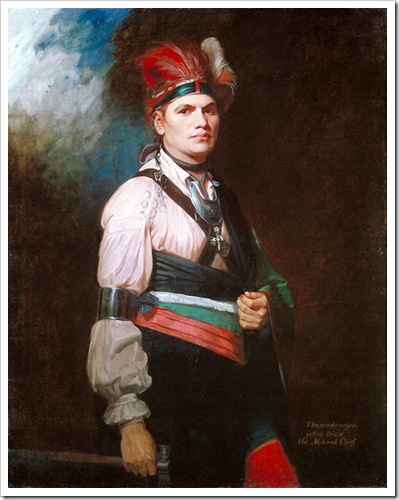
Thayendanagea, [Joseph Brant] the great chief of the Six Nations, who made Fort Haldimand his headquarters. Portrait by the British court artist, George Romney, "Thayeadanegea, Joseph Brant, the Mohawk Chief." 1776. National Gallery of Canada, Ottawa.
The Canadian historian, Ernest Cruikshank, in an article about Fort Haldimand, quoted (1895) Captain Alexander Fraser, who commanded several hundred Canadian Native Americans: “The winter of 1779-80 was memorable for its severity, but scouts were kept out, and the Indians performed this service cheerfully, thanks to [fort designer William] Tice [Twiss] and the Indian officers, but chiefly to Molly Brant, who has more influence than all the chiefs put together; insatiable in her demand for her own family, but checks the demands of others.”
In historical retrospect, Joseph and Molly Brant have become the most famous figures identified with Fort Haldimand, so are subjects of a separate article: Joseph and Molly Brant
Dr. Hough related (1854) that
“Mr. F. R. Hasler, the distinguished mathematician, who for many years had charge of the coast survey, and was then residing in town on the south shore opposite, was appointed to survey the island in 1823, and from his report, we quote the following remarks.
"There are about twenty acres of old improved land near the south shore, called the Kings Garden, which are very good land, the higher part is somewhat stoney, yet not impeding the plowing. The timber generally young, second growth, beech, maple, oak, birch, hickory, and a few pines. Value $5, without the improvements. This lot was about midway between the two extremities on the south side, and a hundred chains fomr the westerly point of the island. At the time of the survey there were 8 log housese and 2 shanties on the island, with 197 acres cleared, and improvements worth $1,020. The total area was 1,274 acres, mostly prized at $4 per acre. The map made by Mr. Hasler, in the state engineer and surveyors office (No. 266) represents the outline of Fort Carlton [sic] as it then existed, and must continue till the end of time, as the excavation that formed the moat was made in the rock.”
The Hasler plan and section of the fort apparently appears at small scale in Houghs article, “Carleton Island and Its Fort.” Hough also noted that Hasler was the eminent [French] philosopher and engineer [who] became interested in real estate in this place, came here to reside with his family, and planned the establishment of a normal school, which he never perfected.”
Hough continued:
“This island became, after the war, an important lumber station, the bays at the head of the island affording a convenient and sheltered place for the making up of rafts. Avery Smith, a Canadian, located here in the business in 1822, and formed a partnership with Abijah Lewis. They afterwards dissolved partnership, and continued the business separately. Schools were established here, a store opened, and twenty or thirty families settled. By an act of April 17th, 1822, a justice of the peace was directed to be appointed. Mr. ____ Shumway was the only one who held the office here. In 1824-5, the business of the place began to decline, and but two families were residing on the island in June 1853. There is scarcely among the lovely scenery of the islands, a more delightful spot than that occupied by the ruins here, and the fruit trees growing abundantly without cultivation in the vicinity evince that the former occupants paid some attention to this branch of husbandry. The trees appear to have sprung from those planted by the English. …” [Native Americans more likely planted the orchard, as this was their custom].
Emerson (1898) noted that settlement was the work of squatters. These improvements are said to have begun in 1822, when Avery Smith and Abijah Lewis began lumbering operations, and in the course of a few years the island possessed a post-office and a school; James Estes had a tavern, and four dwellings were built in the vicinity of the old chimneys on the site of Fort Carleton. A Mr. Shumway taught the school, and also served as justice of the peace to settle any differences which might arise among the settlers; and if local tradition be true, the worthy pedagogue dispensed justice with the same firmness with which he wielded the rod in the school room. Among the other denizens of the locality were David Briggs, who made shoes, and also James Wood and a Mr. Shaw, who kept stores. Abijah Lewis also kept store, and after he and Smith dissolved partnership, each carried on the lumber business alone until the island was practically stripped of its primitive forest growth. This having in due time been accomplished, the business importance of the island passed away, and where once was the semblance of a hamlet only the old smoke colored chimneys survived to mark the historic spot. Subsequently the island was divided into farm tracts, and has since been devoted chiefly to agricultural pursuits, except as non-resident persons have secured small parcels in the most attractive localities and turned them into summer resorts.' The permanent occupants of the island do not number more than half a dozen families."[1898].
Fort Haldimand is listed on the National Register of Historic Places, is a signature property of the Thousand Islands Land Trust, Clayton NY.